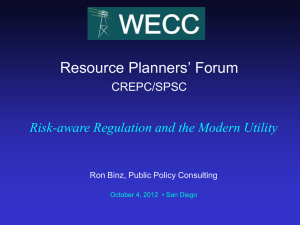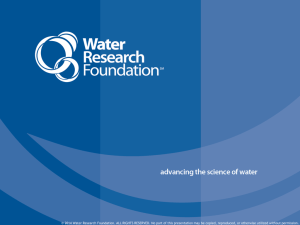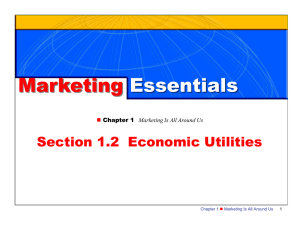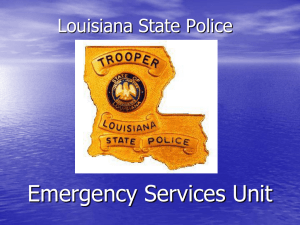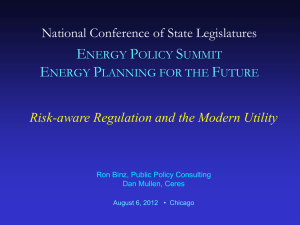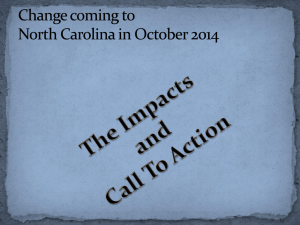"designating". - Missouri One Call System
advertisement
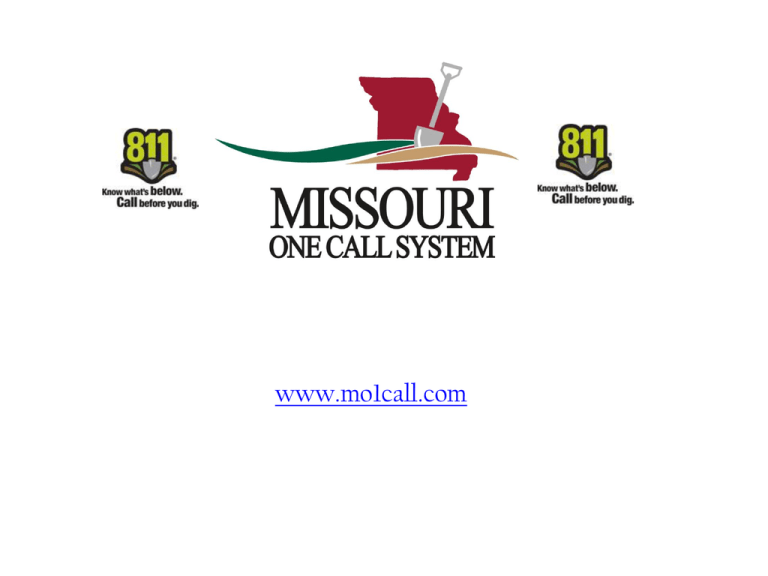
PMissouri One Call System, Inc. 824 Weathered Rock Rd. Jefferson City, MO 65101 www.mo1call.com Bill Dexheimer Field Manager bdex@socket.net Planning and Design in Damage Prevention Reasons to prevent damage Prevention of damage to buried utilities is important for several reasons: Safety Safety is the number reason for preventing damage to buried utilities. Some of the utilities that are buried in the state could, if damaged, pose an immediate threat to the health and safety of excavators and the public. Pipelines Gas lines Electric lines 911 communication lines Financial The cost to repair and restore damaged utilities can be very high, depending on the type of the facility and the severity of the damage. The environmental impact can be devastating in some cases. Court costs and legal fees can be extremely expensive in the event of litigation. Financial (continued) Insurance premiums and deductibles can increase dramatically as a result of damages. Availability of insurance could be jeopardized as a result of damages. Fines and penalties could be levied for violations to Missouri law, OSHA, DNR, and EPA regulations, and local code and ordinance requirements. Financial (continued) Expenses can be incurred from loss of productivity as a result of down time while utilities are being repaired. Public Welfare Damage to buried utilities effects the communities that those utilities serve. These communities consisting of our families, friends, neighbors, and local businesses can be negatively impacted. At the least, they can be inconvenienced, and in a worst case scenario they could be catastrophically impacted. • Even if utilities aren’t damaged during construction, unexpected conflicts with buried utilities can result in significant financial impacts: • • • • Relocation of existing utility Redesign of the project Loss of time Delay of the project Missouri Law Revised statute of Missouri Chapter 319 requires every person excavating in the state of Missouri to make notice at least two but not more than ten working in advance of the excavation. However Waiting until construction is about to begin to obtain information about existing buried utilities ignores a critical opportunity to identify potential utility conflicts. FAILING TO PLAN CAN IN FACT BE A PLAN TO FAIL. Planning and Design The first step in utility conflict avoidance is the consideration of existing utilities in the PLANNING and DESIGN phase of any project involving excavation. Avoiding conflicts with buried utilities is a shared responsibility. If a possible utility conflict is recognized in this phase, viable alternatives can be found to resolve the issue and almost always at a lower cost. Knowledge is power, and in damage prevention, Information is protection. Public Welfare The responsibility of every professional should be a consideration for the public welfare in all aspects of their work. Most would agree that utilities are critical to the public welfare. It follows then that protection of the utilities should be one of the highest priorities on any project being planned and constructed. ASCE CANONS OF ETHICS CANON 1 Engineers shall hold paramount the safety, health, and welfare of the public and shall strive to comply with the principles of sustainable development in the performance of their professional duties. Cannon 1 Continued a. Engineers shall recognize that the lives, safety, health and welfare of the general public are dependent upon engineering judgments, decisions, and practices incorporated into structures, machines, products, processes and devices. Cannon 1 Continued b. Engineers shall approve or seal only those design documents, reviewed or prepared by them, which are determined to be safe for public health and welfare in conformity with accepted engineering standards. Cannon 1 continued c. Engineers whose professional judgment is overruled under circumstances where the safety, health and welfare of the public are endangered, or the principles of sustainable development ignored, shall inform their clients or employers of the possible consequences. An All Too Frequent Scenario The project owner does not consider existing utilities when planning a project. Or if considered: The main concern is the issue of liability instead of damage prevention. Project Owner • The Owner of the project may ,in the scope of work, assign responsibility to the Design engineer for acquiring and mapping utility information. Design engineer The design engineer could do one of two things: 1. Ignore the utilities and put a disclaimer on the design to shift the responsibility to the excavator. 2. Compile utility information from various sources and correlate this data with the site survey for the project. Design Engineer (continued) Being aware of the possibility of the acquired data being incomplete, the Designer would place a disclaimer on the plans and again shift the responsibility to the excavator. (example) “Utility information has been obtained from available records. The actual locations may differ. Contractor to verify all utility locations. Any utilities damaged shall be the responsibility of the contractor”. Contractor The contractor who bids the project based on the depicted utility information, would likely have a contingency built into the construction bid to account for the informational uncertainty surrounding underground utilities and the likelihood that claims, and extended schedules, would have to be developed and negotiated for delays and costs associated with unknown or differing site conditions. Project Owner impacted Depending on the wording of any contingency language in the contract, the project owner could be saddled with additional costs of construction downtime, schedule delays, redesign and utility relocation; and in a worstcase scenario, utility damage, service outages, consequential damages, injury to workers or the public and possible litigation. Although in this scenario attempts are made to avoid liability or shift responsibility, the reality is that unforeseen conflicts can and have resulted in issues affecting all parties involved. The proper approach The owner of the project should assume the initial role of responsibility in ensuring every possible consideration is being given to the protection of subsurface utilities. . As a function of that role: All RFPs and RFQs for engineering and design should include a requirement for the gathering and depiction of existing utility data information on all plans for bidding and construction. The preferable and most comprehensive level of requirement would be ASCE C/I 38-02 as the standard to employ The ASCE C-I 38-02, Standard Guidelines for the Collection and Depiction of Existing Subsurface Utility Data was adopted by the ASCE in 2002. “This National Consensus Standard (NCS) follows the legal procedures for adoption as not only an ASCE standard, but also as an American National Standard Institute (ANSI) standard. “The Justice system holds these standards in high regard, and courts and lawyers use these standards to assist in both defining a professional's standard of care and in adjudication of blame”. (NHWA document) What is ASCE 38-02 “The intent of this standard is to present a system of classifying the quality of existing subsurface utility data. Such a classification will allow the project owner, engineer, and constructor to develop strategies to reduce risk, or at minimum, to allocate risk due to existing subsurface utilities in a defined manner”. (NHWA document) Supporters of 38-02 The NTSB, AGC, ASCE, FHWA, NUCA, AASHTO, NCHRP, APWA and other organizations are firmly behind this standard development and implementation. The Common Ground Alliance also stresses the importance of providing this level of information on designs and plans. The Common Ground Alliance (CGA) was established as a result of a U.S. Department of Transportation sponsored study of best practices for Damage Prevention. CGA promotes damage prevention as a SHARED RESPONSIBILITY The CGA promotes several best practices involving Planning and Design. CGA Best Practices Practice 2-1 Plats prepared for the development of real property should identify and show the alignment of any existing buried facilities and the presence and extent of any existing easements and or rights of way. CGA Best Practices Practice 2-2 Designers should use all reasonable means of obtaining information about underground facilities in the area of the planned excavation. CGA Best Practices 2-3 Designers should indicate existing underground facilities on drawings during planning and design. 2-14 Advocates the proper application of Subsurface Utility Engineering(SUE) practices as a means of providing significant cost and damageavoidance benefits. APWA Guidance Position Statement “The APWA believes that the public interest is best served when governmental agencies follow the guidelines for subsurface utility engineering(SUE) described in the ASCE Standard Guideline for the Collection and Depiction of Existing Subsurface Utility Data (ASCE 38-02).” (APWA Guidance Position Statement) SUE • The ASCE standard defines SUE as a branch of engineering practice that involves managing certain risks associated with: • utility mapping at appropriate quality levels, • utility coordination, • utility relocation design and coordination, • utility condition assessment, • communication of utility data to concerned parties, • utility relocation cost estimates, • implementation of utility accommodation policies, and • utility design. These activities, combined with traditional records research and site surveys, and utilizing new technologies such as surface geophysical methods and non-destructive vacuum excavation, provide "quality levels" of information. Quality levels of SUE There are four recognized quality levels of underground utility information ranging from Quality Level (QL) D (the lowest level) to Quality Level A (the highest level). Quality Level D • Quality Level D. QL-D is the most basic level of information for utility locations. It comes solely from existing utility records or verbal recollections, both typically unreliable sources. It may provide an overall "feel" for the congestion of utilities, but is often highly limited in terms of comprehensiveness and accuracy. QL-D is useful primarily for project planning and route selection activities “Quality Level D” The least reliable utility data • Plotted on plans from records. • Sometimes a field visit - to look for utility indications on the site - is made. • Sometimes “verbal recollections” are plotted. This level of effort is great for Project Planning purposes, utility “inventories,” and very preliminary utility relocation cost estimates Preliminary Design Missouri One Call System provides for a preliminary design request to be used to acquire contact information for buried utility owners in the area of the project. A list of the names of the utilities with contact numbers will be emailed to the planner as a result of this request. Quality Level C Quality Level C. QL-C is probably the most commonly used level of information. It involves surveying visible utility facilities (e.g., manholes, valve boxes, etc.) and correlating this information with existing utility records (QL-D information). When using this information, it is not unusual to find that many underground utilities have been either omitted or erroneously plotted. Its usefulness, therefore, is primarily on rural projects where utilities are not prevalent, or are not too expensive to repair or relocate. “Quality Level C” The “traditional” utility depiction • Surface Appurtenances are surveyed and accurately plotted on a current site plan • Utility data from records (QL D) are correlated to the appurtenances Problems with records interpretations still exist: e.g. schematics, no appurtenances depicted, utilities not straight between appurtenances, no records exist, and so on. Quality Level B Quality Level B. QL-B involves the application of appropriate surface geophysical methods to determine the existence and approximate horizontal position of virtually all utilities within the project limits. This activity is called "designating". The information obtained in this manner is surveyed to project control. It addresses problems caused by inaccurate utility records, abandoned or unrecorded facilities, and lost references. The proper selection and application of surface geophysical techniques for achieving QL-B data is critical. Information provided by QL-B can enable the accomplishment of preliminary engineering goals. Decisions regarding location of storm drainage systems, footers, foundations and other design features can be made to successfully avoid conflicts with existing utilities. Slight adjustments in design can produce substantial cost savings by eliminating utility relocations. “Quality Level B” A significant upgrade in quality • Surface Geophysical Methods used to search for and trace existing utilities. • Designated utilities are then surveyed and plotted on site plan. Non-recorded utilities found. Utilities’ routes between appurtenances are imaged. Typically used in early preliminary design for construction footprint decisions. Possible changes to ASCE 38-02 Change Details Explicit Change to QLD Source Information “One-Call markings (These marks are placed by others. The engineer has no control over these marks or knowledge of their integrity. These marks can be recognized only as a source of nonqualified information. Survey of these marks leads only to QLD information, not QLB information)” Change Details Explicit Change to QLD Source Information “One-Call markings (These marks are placed by others. The engineer has no control over these marks or knowledge of their integrity. These marks can be recognized only as a source of nonqualified information. Survey of these marks leads only to QLD information, not QLB information)” Reason Perhaps the largest mis-use of ASCE 38 has been the survey of one-call marks and subsequent depiction of them as QLB. The new addition will specifically say this is not a procedure that leads to QLB data. In some cases it may not even lead to QLD. Missouri One Call System provides a design request ticket that allows for requesting the marking of the approximate location of buried utilities at the project site. The approximate location is defined as “a strip of land not wider than the width of the underground facility plus two feet on either side thereof”. Marking Missouri One Call is promoting the use of the Missouri Common Ground Marking Guidelines. Following these guidelines will allow for the communication of vital information about the buried facility. This information will give a more accurate picture for design decisions. Missouri Statute • 319.027. 1. Any person may make design requests by contacting the notification center. Such design requests shall include all information deemed necessary by the notification center to complete the notice, including the identification of the person and a description of the location of the project being designed and other information similar to that required of excavators under section 319.026. • 2. Design requests shall be made to the notification center at least five working days, but not more than ten working days, before the date the person has requested receiving the information from the underground facility owner. Upon receipt of a design request, the notification center shall inform the person of the name of all notification center participants to whom the notice will be transmitted and shall promptly transmit such notice to the appropriate underground facility owners. • 3. Every underground facility owner who receives a design request shall mark the location of the facility, or contact the person making the request, within five working days after the date the notice was received from the notification center. If the person making the request was contacted as an alternative to marking location, the person and the underground facility owner shall mutually agree on a schedule and method for providing the information [.] provided that the facility shall be marked within five working days if the facility owner and the excavator making the request are unable to agree. • (bold type is an addition in proposed legislative changes) • 4. No excavation may be commenced based upon information received through a design request. Obtaining information through a design request shall not excuse any person commencing an excavation from making notice and obtaining information under sections 319.025 and 319.026 concerning the possible location of any underground facilities which may be affected. • Design ticket If stakes or pins are being driven, this constitutes excavation and requires an excavation notification instead of a design request. Requests can be made by calling : 1-800-DIG RITE or 811 or By internet at mo1call.com using our ITIC program The login page has been simplified and includes an option to request a live chat, with an ITIC representative, if you have a question or require help to get logged in. Once logged in, navigation aids in the header and footer provide a consistent look and make help easy to acquire. The first page of the locate request form auto-fills with your information and is available for edit if any information is incorrect. The excavation information page is blank and can be filled out easily using drop down menus and ‘match-as-you-type’ entry. Work profiles are also available. These profiles can be set up to auto-fill the excavation information. Multiple profiles may be configured and managed by the user. The map is integrated into the page and displays search results as you enter information. The ITIC 2.0 map has three default views which can be selected by clicking on the preferred view at the top right of the map. This is the OCC map view. This is the Satellite view. And this is the Google street view. After completing the ticket, the start date and time are set with an easy to use drop down for time and a clickable calendar for dates. Only the appropriate dates are available for selection. A ticket that is mapped by a user will then display the list of utilities, and any other configurable information. Any completed ticket results in a copy being sent back to the user along with information appropriate to the ticket. A link is included allowing the user to view the complete ticket and map. No Response If a facility owner fails to respond to a request for a locate, a “No-Response” request should be made to Missouri One Call. The utility must respond within two hours by contacting the excavator or marking. If the notice is received before 2 p.m., the facility must be MARKED by the end of that day. If received after 2 p.m., it must be Marked by 10 a.m. the next working day. It is important that the utility that has not responded be specified. After obtaining this information, the engineer can develop a conflict matrix to determine if additional information is needed. If the matrix indicates that potential conflicts exist, then more detailed information can be obtained for those specific locations. This next step is level A in ASCE 38-02. Quality level A Quality Level A. QL-A, also known as "locating", is the highest level of accuracy presently available and involves the full use of the subsurface utility engineering services. It provides information for the precise plan and profile mapping of underground utilities through the nondestructive exposure of underground utilities, and also provides the type, size, condition, material and other characteristics of underground features. “Quality Level A” A guarantee in 3-D Typically used in final design stages. Allows small adjustments in design for big savings in construction • Utilities exposed via non-destructive air-vacuum means • Exposed utilities are then surveyed and plotted on site plan Elevations, Size, Condition, Materials, Precise Horizontal Positions are measured and documented The highest level of accuracy and comprehensiveness is generally not needed at every point along a utility's path, only where conflicts with design features are most likely to occur. Hence, lesser levels of information may be appropriate at points where fewer conflicts or no conflicts are expected. The project owner will specify to the engineer the desired quality level of utility data. The engineer will furnish the desired utility quality level to the owner in accordance with the standard of care. . On many small projects, where few subsurface utilities are present, and/or where information about subsurface utilities is believed to be generally accurate and comprehensive, this will only involve making a conscious decision to proceed with the project using readily available information. On larger projects, where information about subsurface utilities is not believed to be generally accurate and comprehensive, this may involve employing the services of a Subsurface Utility Engineer (SUE) to provide expert advice and to use available technologies to provide better information. Depiction Once collected the utility data should be depicted on all plans for bidding in accordance with ASCE 38-02 guidelines. Cost savings • A study sponsored by the FHWA and conducted by Purdue University found that USD$4.62 was saved on overall project costs for every dollar spent on SUE. This figure was quantified by a study of 71 projects that had a combined construction value in excess of $1 billion. • Qualitative savings were not measurable, but it was clear that those savings were also significant and may have been many times more valuable than the quantifiable savings. A 2005 University of Toronto study of nine infrastructure projects found the Return-onInvestment for SUE is approximately $3.41 for each $1 spent. PennDOT in a study of 10 highway projects identified a savings of $22.21 for every $1.00 spent on SUE. The 10 projects had a total project cost in excess of $120 million. Studies also suggest that SUE services typically range from 0.5% to 1% of the Design/Construction budget. One study estimates a 10-15% total project cost savings by improving the data quality level to A or B from C or D. (Stevens, R.E. (1993). Society of American Value Engineers, General Percentages of Cost Savings) The costs of obtaining SUE quality level A and/or B were less than 0.6% of the total cost and this resulted in a cost savings of 15% over traditional quality levels. The study showed that SUE benefits are high even if the total project cost is low. The benefit-cost of SUE increases as the utility complexity level of the project increases. Providing this information on plans does not relieve the excavator of the responsibility of making a locate request but it does add another layer of protection that has too often not been utilized. Everyone wins when utility conflicts are avoided Project owner Provides detail for making informed decisions. More accurate bids from constructors Reduces risk Saves money Demonstrates professionalism Enhances public image Engineer/Designer Provides information to assist in designing the right project the first time. Reduces the need for change orders and redesigns. Provides opportunities for communication, cooperation, and coordination instead of conflict. Enhances image because it is the professional and ethical thing to do. (Having your name identified with a noteworthy incident can negate a years worth of marketing). Constructor 1.Provides detail for appropriate bidding. 2. Helps eliminate delays and lost time expenses. 3. Enhances safety. Utilities Provides advance information on upcoming projects. Eliminates extra locates by potential contract bidders. Reduces damages thereby: a. Reducing service outages. b. Preserving the integrity of the existing facility. c. Reducing interruptions of scheduled work. Helps eliminate emergency relocations of facilities. General Public 1. Avoid interruptions of service. 2. Provides an additional layer of protection from possible catastrophic utility damages. Collecting and depicting quality utility data should not be viewed as an additional expense, but should be seen as an investment in the safety and welfare of all concerned and the overall success of the project. It is the professional, ethical, economical, and safe approach for designers to take on projects involving excavation. Additional thoughts Consideration should also be given to identifying private facilities. A note reminding the excavator to contact Missouri One Call before excavating should be placed on all final plans involving excavation. If you are designing the placement of a buried utility, make provision for it to be locatable in the future. Future programs Missouri One Call is working to enhance damage prevention through improved electronic information exchange programs. One program will allow the designer to provide an electronic copy of their planned project to utilities through the Call Center. Another program will allow designers to provide virtual WHITE LINING of the design. Missouri One Call Website For information relating to Design requests, visit our website, mo1call.com and click on the Design Ticket tab on the home page. Missouri One Call is working on a resource library that will provide contact information for various service providers. (SUE providers, Vacuum excavators, etc.) Missouri One Call provides free promotional materials which can be ordered via the website. • QUESTIONS?
